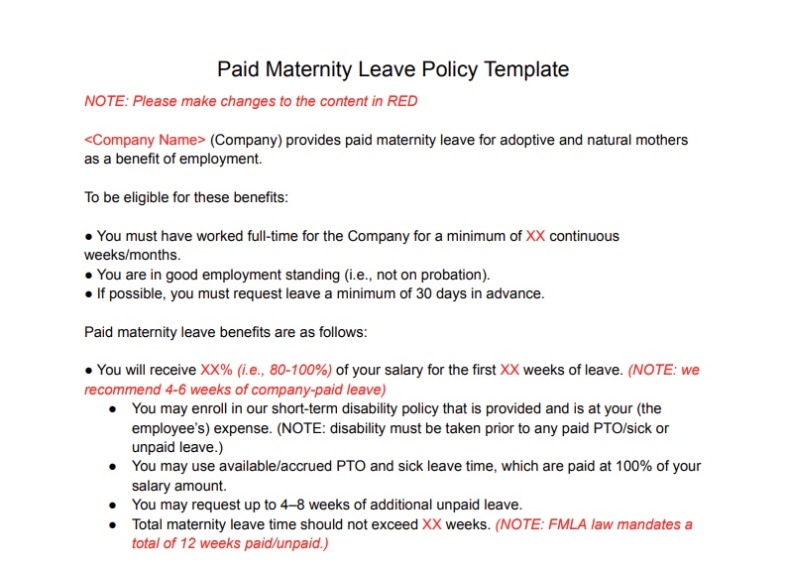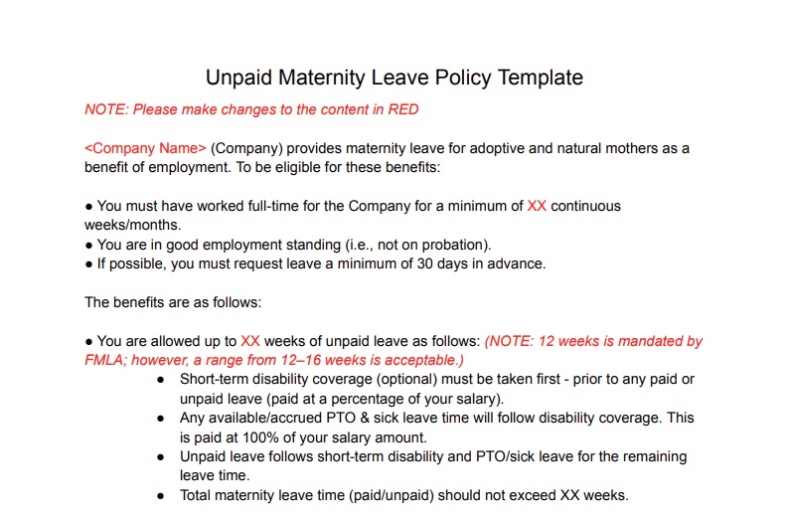A maternity leave policy covers employee eligibility and maternity leave duration, along with benefits and other details associated with your policy. Under the federal Family & Medical Leave Act (FMLA), employers with 50 or more employees must provide unpaid maternity leave. Some states, however, require paid maternity leave, and some businesses choose to offer paid maternity leave regardless of the base requirement.
Key Takeaways:
- Companies with more than 50 employees are required to provide at least 12 weeks of unpaid maternity leave.
- Some states require paid maternity leave, even for companies with less than 50 employees.
- A maternity leave policy can help outline expectations and benefits.
You can create and customize your maternity leave policy to ensure federal and state compliance and provide written documentation for your employees. Download either our paid or unpaid maternity leave template below.

Thank you for downloading!
If you are looking for a more professional way to create policies, including a maternity leave policy, consider using Homebase. It offers templates for your policies in one convenient place and has a built-in time and attendance tracker that will help you manage your employees’ maternity leave.

Thank you for downloading!
If you are looking for a more professional way to create policies, including a maternity leave policy, consider using Homebase. It offers templates for your policies in one convenient place and has a built-in time and attendance tracker that will help you manage your employees’ maternity leave.
What to Include in Your Maternity Leave Policy
Every maternity leave policy should include vital information that explains exactly what the procedures are for taking a leave. This includes:
- Who is eligible: adoptive and natural mothers
- Terms of eligibility: full-time employment and/or number of consecutive weeks/months worked, employee standing, and request time frame
- Benefits included: short-term disability, use of accrued/unused PTO/sick leave, unpaid leave, and total number of weeks allowed
- Health insurance coverage: company or employee-paid coverage
Be sure your policy also touches on whether or not the company pays for any part of the maternity leave. You can elect to pay employees for a certain timeframe (typically 4-6 weeks) and then allow employees to use short-term disability, PTO and sick leave, and unpaid leave for the remaining time allowed.
Administering Your Maternity Leave Policy
After developing your maternity leave policy, provide employees with a copy and have them sign and date the policy.
Be sure to follow these general guidelines:
- Update your employee handbook to include verbiage about your maternity policy.
- Document their acknowledgment of the policy in their personnel files.
- Be mindful of laws in your state and federal laws that state you must abide by any policies you have in place.
If you are looking for HR software to help you create and manage your time off policies, consider Homebase. It has an array of HR features, including scheduling, time tracking, payroll, hiring and onboarding, team communications, HR compliance, policy management, and more. Plus, it’s free for small businesses with one location and up to 20 employees.
Federal Maternity Leave Laws
If your business has 50 or more employees, the FMLA requires you to provide up to 12 weeks of unpaid maternity leave. If you employ less than 50 employees, there is no federal labor law requiring you to provide maternity leave; however, we recommend it as a good business practice.
Although not directly related to maternity leave, you should also be aware of the Pregnancy Discrimination Act, which applies to companies with 15 or more employees. This act prohibits discrimination based on pregnancy, childbirth, and related medical conditions. For instance, if you allow other disabled employees to work from home, you must offer that option to your pregnant employees as well.
There are three phases of maternity that have specific laws that companies must follow:
- Working while pregnant
- Leave to prepare for, deliver, and care for a newborn
- Return to work
Phase 1: Employee Working While Pregnant
Title VII of the Civil Rights Act of 1964, which includes the Pregnancy Discrimination Act (PDA), applies when you have an employee who is pregnant. Although it applies to employers with 15 or more employees, we recommend all employers follow the guidelines as a best practice.
While an employee is pregnant, they are further protected by the Americans with Disabilities Act (ADA), which applies to any employer with 15 or more employees. The ADA stipulates that reasonable accommodations must be made for the employee to do their job successfully, similar to any other employee with a disability or special need. For example, the employer may need to offer light-duty work, alternative assignments, disability leave, or unpaid leave to pregnant employees.
Some examples of reasonable accommodations include:
- Providing a lumbar support pillow if the expectant mother is having back pain
- Offering a chair for them to sit in (for jobs that normally require standing) so that they don’t have to stand for hours
- Allowing them extended breaks for morning sickness or restroom use if requested
Keep in mind that new employees are just as protected by the federal anti-discrimination legislation as employees who have been with you for 10 years. Even though your employee is new, they should be treated just like other employees. However, they are not eligible for FMLA leave until they have been employed by you for one year.
Phase 2: Employee on Maternity Leave
As a private employer with 50 or more full-time employees, you are required to allow new mothers to take unpaid maternity leave (up to 12 weeks) while guaranteeing that they will have a job when they return, either in the same position or a similar one. However, if you employ fewer than 50 full-time employees, under federal law, you have no obligation to provide maternity leave.
You are also required to continue group health insurance coverage and cannot penalize the time away from work as an absence.
Related Articles:
Phase 3: Employee Returning to Work
An employee returning to work after maternity leave has the following rights:
- The right to return to their previous position (or a similar role)
- The right to not be discriminated against due to taking medical leave
- The right to return on a flexible, or altered schedule (such as part-time or work-from-home)
There are also laws in place to protect their right to pump or express milk. A breastfeeding mother who returns to work has a right to pump in the workplace under a provision of the Patient Protection and Affordable Care Act, which covers work regulations like minimum wage, breaks, and record-keeping. As the employer, you are required to provide them with adequate break time and a clean, private place to pump.
Compliance with this law is required for all employers regardless of size. However, if you have fewer than 50 employees and can prove an accommodation provides an undue hardship on your business, you may be exempt. Undue hardship is defined as, for example, the need to do construction on your employment site to provide a private room for pumping. You can find more information about complying with the law from the US Breastfeeding Committee.
You cannot fire an employee because they’re pregnant. You must show the employee was terminated for a reason completely unrelated to their pregnancy. To do that you will need to extensively document the employee’s poor performance and your company’s support to help them improve.
Terminating a pregnant employee, whether they’re recently pregnant or on maternity leave, is legally tumultuous territory. Even if you have your documentation in order, you could still face a wrongful termination lawsuit, which could result in thousands of dollars in legal expenses.
A better option would be to provide coaching and training on their work performance and continue to document performance issues. Then, if those issues continue after their maternity leave is over, consider waiting (a minimum of three months) after your employee has returned to work before considering letting them go. Always document performance review meetings, coaching sessions, and training, and discuss with your attorney before taking action.
For employees currently on maternity leave, if you employ fewer than 50 people, you have no obligation to guarantee your pregnant employees a job when they return to work. However, if you have a policy that states that you provide maternity leave, or if you allow other disabled workers to take an extended leave of absence, then you must abide by your policy and precedent.
State Maternity Leave Laws
While there is no federal law requiring parental leave for businesses with fewer than 50 employees, your state may have additional laws that you must comply with.
And, it also depends on what you’ve done in the past. If your paid time off policy states you provide maternity leave, or if you allowed another mom flexibility, such as working from home, then you must abide by that precedent.
Choose your state from our drop-down menu to understand the maternity leave laws by state that apply to your business and how they may differ from federal law. If your state is not listed, it doesn’t have a specific maternity leave law.
Under the California Family Rights Act (CFRA), employers with five or more workers must provide eligible employees with up to 12 weeks of unpaid, job-protected leave over 12 months for certain qualifying reasons.
California also requires employers to provide paid leave for employees who have worked for the company for at least 12 months and at least 1,250 hours during the previous year. Workers falling under this requirement are entitled to up to eight weeks of paid leave and will be paid approximately 60% to 70% of their average weekly wage—up to a maximum benefit of $1,357 per week.
Colorado’s Family and Medical Leave Insurance Program (FAMLI) program, which began January 1, 2024, states that employers with at least one employee for at least 20 weeks in a year must provide up to 12 weeks of paid leave—and an extra four weeks for those who experience complications in pregnancy or childbirth.
The Connecticut Family Medical Leave Act (CFMLA) gives employees the right to take up to 12 weeks off in any 24-month period for a serious health condition, which includes pregnancy. Employees are also eligible for an additional two weeks of paid leave under this program if they’re unable to work because of a serious health condition related to their pregnancy or childbirth.
To be eligible, an employee must have worked for your company for at least 12 weeks. When on leave, they’ll be paid their regular wage or up to 60 times the Connecticut minimum wage.
The Healthy Delaware Families Act requires employers with at least 25 employees to provide up to 12 weeks of paid family leave.
Note: This law has been signed, but employees cannot take advantage of the paid leave benefits until January 1, 2026—though employers will begin deducting premiums starting January 1, 2025.
Washington, D.C., requires employers with employees who work at least 50% of the time inside the District to provide up to 12 weeks for the employee to bond with a new child and two weeks to receive prenatal care. A worker will receive 90% of their regular wage, up to $912 per week, and 50% of their remaining weekly pay, with a cap of $1,009 per week.
Hawaii employers must allow employees who have worked at least 12 months to take four weeks of unpaid leave while they are disabled due to pregnancy, childbirth, and related conditions. All working women are eligible; company size does not matter.
Maine employers with more than 15 employees must give eligible employees up to 10 weeks off in a two-year period for the birth or adoption of a child.
Note: On July 11, 2023, a historic budget was signed that includes the creation of a paid family and medical leave program. Beginning in 2026, eligible workers in the private and public sector will have 12 weeks of paid time off available for family or medical reasons including illness, to care for a relative, or the birth of a child.
Beginning July 1, 2026, Maryland employers will be required to offer paid family and medical leave. Workers will be allowed to take time away from work to care for themselves or a family member (including pregnancy and birth). They will also be eligible to be paid up to $1,000 per week for 12 weeks.
Employers in Massachusetts with at least 25 employees must give eligible employees up to 12 weeks off for the birth or adoption of a child. All W-2 employees, self-employed workers, and some 1099 independent contractors are eligible. The benefit amount received is calculated based on an employee’s weekly wage and the Massachusetts average weekly worker wage, up to a maximum of $1,129.82 per week. The maximum weekly benefit before then is $1,084.31.
Minnesota employers with at least 21 employees must allow eligible employees to take up to 12 weeks off for prenatal care, pregnancy, childbirth, and bonding with a new child. Bonding leave is available to biological and adoptive parents but must be taken within 12 months of the child’s birth or adoption. To be eligible for leave, the employee must have worked at least halftime for the employer for 12 months before the leave request.
The Granite State Paid Family Leave Plan provides employees with up to 60% of their average weekly wage for up to six weeks per year. Note that this is a voluntary plan for private employers in New Hampshire.
New Jersey employers with at least 30 employees must provide their workers with up to 12 weeks of leave in a 24-month period to bond with a child. The employee must have worked at least one year with the company to be eligible. Workers receive up to 85% of their average weekly wage, up to a maximum weekly benefit of $993.
New York Paid Family Leave requires employers to provide up to 12 weeks of paid leave for employees who work at least 20 hours per week. To be eligible for this benefit, employees must have worked for a company for at least 26 consecutive weeks. Workers get 67% of their average weekly wage, up to a maximum of $971.61.
Oregon Paid Leave is one of the newest programs. Companies with at least 25 employees pay into the program and employees can receive benefits. Employees can take up to 12 weeks of paid leave and an additional two weeks if they have medical issues related to the pregnancy. Employees will be paid up to 100% of their average weekly wage. Employers with fewer than 25 employees do not have to pay the employer portion of the program—employees, however, are still eligible.
The Rhode Island Temporary Caregiver Insurance Program provides up to four weeks of paid maternity leave and up to 30 total weeks if pregnancy-related medical conditions prevent the employee from working. The benefit maxes out at $1,007 per week and is based on the employee’s highest earning quarter in the last year.
Employers in Vermont with at least 10 employees must provide unpaid time off to eligible employees for pregnancy, childbirth, or adoption of a child up to 16 years old. They may take up to 12 weeks of family and medical leave in a 12-month period.
In 2014, Vermont enacted a law that gives employees the right to request a flexible working arrangement up to twice a year. Such an arrangement might involve a change in work hours (for example, to begin and end work later), working from home, changes to the number of hours or days an employee works, or job sharing.
The Paid Family and Medical Leave program, a Washington state-run insurance program, provides up to 12 weeks of paid leave for bonding with a newborn. Employers can provide paid family and medical leave benefits either through the state-run program or purchase a voluntary private plan that provides benefits equal to or greater than the state minimum requirements.
Maternity Leave Policy Options
Here are several options for customizing a maternity leave policy for your company. We recommend a combination of these to support your business and show care for your employees fairly and inexpensively while creating a great company culture.
- Provide Unpaid Maternity Leave: Consider offering a set amount of unpaid leave, such as 12 weeks, or have that range be decided by the employee and simply state that they may take “up to 16 weeks,” which is the maximum generally offered by small businesses.
- Offer Remote or Work-from-Home Options: Allow new moms to work from home once they feel well enough and have exhausted their paid or unpaid leave. Stay in touch with the new mom as their desire to work from home may change once the baby arrives. In addition, you may need to provide them with work-from-home tools, such as a cellphone, internet, and computer.
- Allow Flexible Scheduling: Provide a flexible work environment and flexible schedule, such as part-time, or fewer, longer days that add up to their regular hours. Or consider allowing the new mom to come in as they are able, once recovered from the delivery.
- Provide Short-term Disability Insurance: Short-term disability insurance at the employee’s expense can be added to your benefits package. This is a great perk for employees who value family and is at no cost to you as the employer.
- Offer Paid Maternity Leave: You can offer paid maternity leave, which is becoming more popular. This paid leave can be offered at a percentage or a flat rate for a certain number of weeks.
You may also need to consider policy options for specific situations, such as during an employee’s first year on the job or for remote employees.
Maternity Leave Policy Frequently Asked Questions (FAQs)
There is no set time (or law) that dictates when a pregnant employee can go on maternity leave. Many women begin their FMLA leave a week to a month before their due date because of discomfort or complications with their pregnancies. The only stipulation is the total amount of weeks allowed for leave (up to 12 weeks). Any time a pregnant employee takes off before the birth of their child will count towards that 12 weeks.
Yes. The following states require maternity leave to be paid: California, Colorado, Connecticut, D.CMassachusetts, New Hampshire, New Jersey, New York, Oregon, Rhode Island, and Washington State. The following will begin paid maternity leave in 2026: Delaware, Maine, and Maryland.
Yes. Although the American College of Obstetricians and Gynecologists (ACOG) recommends women take at least six weeks off work following childbirth, no law requires it. Sometimes women return early due to finances, so by offering paid leave plus short-term disability plus PTO/sick time usage, women can get the adequate rest and bonding time they need.
Bottom Line
Providing paid maternity leave can be a great way to differentiate your company from competitors and help retain your best talent. Considering how much it costs to recruit and train a new employee, a maternity policy, whether paid or unpaid, can make sense for your business. It also leads to a positive company brand image and helps retain good employees.


